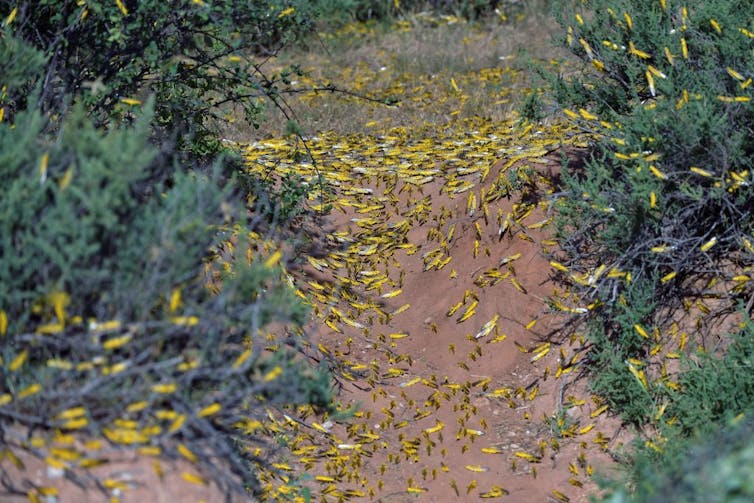A new model shows where desert locusts will breed next in East Africa
A group of scientists has identified and mapped potential breeding regions of the desert locust in Kenya, Uganda and South Sudan.
Several countries in East Africa – namely Kenya, Ethiopia, Uganda and South Sudan – are still trying to contain the worst desert locust invasion the region has experienced in over 70 years. The locusts have destroyed vegetation – especially staple cereal crops, legumes and pastures – resulting in huge economic losses. The World Bank estimates that these losses could reach US$8.5 billion by the end of the year.
Unlike many other grasshoppers, the desert locust (Schistocerca gregaria) can change from a harmless solitary phase to a destructive gregarious phase whereby hoppers (juveniles in their early, wingless stages) march together in bands. The adults can fly and form giant swarms that can invade large areas away from their original breeding sites.
Currently, the countries are battling the second generation (or wave) of locusts, as they’ve already reproduced and hatched once within the region. And re-infestation could continue if the environment is conducive to it.
The desert locust breeds well in semi-arid zones. An ideal breeding site is characterised by warmth, vegetation close by and sandy soil with moisture and salt in it. The females usually lay their eggs at between 4 and 6 cm deep in the soil.
Governments have tried to control these insects through a range of efforts: from mobilising military units to using young people as locust cadets.

Locusts aggregate on the ground on January 22, 2020 at Lerata village near Archers Post in Samburu county. TONY KARUMBA/AFP via Getty Images
But trying to control and eliminate populations of flying locusts is expensive and not very effective. The best option, proved by scientists, is to manage them at their breeding sites.
Eggs survive and hatch when the environmental conditions are right – they can hatch within weeks or remain undeveloped for years. They’re laid inside soil so can be hard to find, it’s best that control measures – preferably biopestcides – are used when the locusts are at the surface in the form of a nymph or hopper. For this to happen, targeted ground and aerial surveillance efforts to identify potential breeding sites are critical.
The most destructive locust swarm in East Africa happened over 70 years ago. Documentation of information was very poor and so there was no prior knowledge of the region’s potential breeding sites.
Along with my colleagues from the International Centre for Insect Physiology and Ecology, I’m trying to fill this gap. We’ve developed maps that predict where desert locusts could breed in Kenya, Uganda and South Sudan.
Our model, supported by a machine learning algorithm, establishes a relationship between historical data from around the world on desert locust breeding sites. It also factors in climate and soil characteristics that are necessary for locusts to lay their eggs, and for the eggs to hatch.
Breeding sites can consist of anywhere between 40 to 80 million locusts within a square kilometre. There is a need to target these high-risk areas and strengthen ground surveillance to manage the locusts in a timely, cost-effective, and environmentally friendly manner.
AT-RISKS AREAS
Using the model, we’ve identified and mapped potential breeding regions of the desert locust in Kenya, Uganda and South Sudan.
Vast areas in Kenya are at high risk because they have the right conditions to support locust breeding. These areas include Mandera, Wajir, Garissa, Marsabit, Turkana (all counties in North Eastern Kenya) and a few sites in Samburu county.
In Uganda, there are fewer possible breeding sites than in Kenya. These are restricted to the north-eastern regions, specifically Kotido, Kaabong, Moroto, Napak, Abim, Kitgum, Moyo, and Lamwo districts.
South Sudan is at risk of breeding in the northern regions and the south east corner bordering Kenya. These sites exist in northern Bahr el Ghazal, Unity, Upper Nile, Eastern Equatoria, Warrap, Lakes, and some parts of Jonglei state.
ACTIONS
In line with these predictions, ground and aerial surveillance efforts and monitoring of weather and vegetation variables in the predicted breeding regions needs to be strengthened significantly.
Financial, material and human resources will also need to be mobilised for timely management of the hopper bands when they emerge.
We, at the International Centre for Insect Physiology and Ecology, have several suggestions on what must happen next:
- Due to a large area for potential breeding of locusts, a permanent locust monitoring unit in Kenya must be established. It should consist of ground and aerial surveillance teams, locust biologists, socio-economists, remote-sensing experts and weather and vegetation forecasters.
- A task force must be set up in Uganda to collaborate with Kenya’s monitoring unit. Based on the overall cover area of desert locust breeding suitability in Uganda, it may not be necessary to invest in constant monitoring in the country. But the task force must collaborate closely with the Kenyan Locust monitoring unit and enhance preparedness for possible outbreaks and swarms.
- Sustainable locust management interventions and associated mobilisation of financial, logistical and human resources need to be closely linked with strengthened locust monitoring efforts.
- There must be a greater focus on sustainable and biological control options against locusts to mitigate adverse impacts of chemical pesticide-based locust control strategy. We believe that biopesticide applications should become a cornerstone in managing locust outbreaks. Biopesticides needs to be rapidly field tested in Kenya, commercialised and scaled up.
Finally, the current desert locust outbreak is triggered by a change in rainfall pattern which expands areas of potential invasion as a consequence of climate variability or change.
It is possible that, in the future, other marginally suitable areas and conditions may become conducive for locust breeding. Therefore, it is important to ramp up modelling efforts to understand the potential impacts of climate change on the current model predictions.![]()